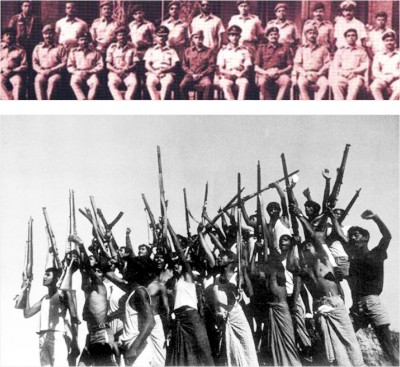
|
Home |
Issues | The Daily Star
Home
|
|
|
Book review Today's perhaps most popular writer, Humayun Ahmed's “Josna O Jononir Golpo” is an excellent book on the war. His unique way of story telling mixed with his trademark writing style give us quite a treat to read. In this novel we find the writer's personal experiences portrayed along with various others. The most amazing thing about this novel is its portrayal of people from nearly all sections of the society. We have Shahed, an ordinary service holder, Irtazuddin, his brother and a devoted Muslim, Shahed's friend Gouro, Shah Kalim, a sly poet, Shahed's other friend Nazmul, a valiant freedom fighter and many others. We get a quite a clear conception of the mindset of the people of different backgrounds. Mr. Ahmed mixes their stories with apparent ease, frequently mentioning confirmed facts about the affairs. I can assure you that this is one book you cannot put down until the end. The cheeky dialogues, Humayun Ahmed's characteristic philosophical remarks, and above all the amazing story of our freedom makes this book really a masterpiece and obviously a must read on the subject of liberation. Naming even five prominent writers of modern times in Bangladesh cannot leave out Anisul Hoque. He is perhaps more famous for his light-hearted novels and screen-plays, but his “Ma” novel comes out in a serious tone. This is also a novel on the liberation war. Contrary to the novel mentioned previously, it deals with the life of one individual only. This person is the mother of another valiant freedom fighter Azad. This novel is based on facts and sometimes discloses first hand accounts of the events. Shahid Azad was the only son of Younus Choudhury and Safia Begum, a very rich and powerful couple. Azad's mother broke up with his dad and lived with Azad in quite a lowly way compared to their previous state. Azad grew up to be a very fine and peace-loving young man. But even he could not deny the call of the motherland to free her soul of oppressors. He joined the liberation war and after some successful missions he was capture by the Pak army. He died without betraying his companions. His last words to his mother were to eat a plate of rice and hope for a pillow in the jail. In memory of her only son, Saphia Begum refrained from having rice and sleeping on the bed for the rest of her life. This novel is quite heart touching and is also a great book to learn about the liberation war. Somoy publications published this book and I should recommend everyone to at least try this book. I can guarantee you won't be disappointed. By Jawad Mahmud Sectors of '71 the pillars of resistance  During Bangladesh Liberation War of '71, our country was divided into eleven sectors according to geographical and operational ease. Each sector had a sector commander, who directed the guerrilla warfare. For better efficiency in military operations each of the sectors were divided into a number of sub-sectors. During Bangladesh Liberation War of '71, our country was divided into eleven sectors according to geographical and operational ease. Each sector had a sector commander, who directed the guerrilla warfare. For better efficiency in military operations each of the sectors were divided into a number of sub-sectors.
Cabinet meeting of Bangladesh government of July 11, 1971 appointed Col. M A G Osmani as Commander in Chief, Lt. Col. Abdur Rab as Chief of Army Staff and Group Captain A K Khandker as Deputy Chief of Army Staff and Chief of Air Force. In this meeting, Bangladesh was divided into Eleven Sectors under the Sector Commanders. Sector 1 The sector composed of Chittagong District, Chittagong Hill Tracts and the entire eastern area of the Noakhali District. The headquarters of the sector was at Harina. Sector 2 The sector consisted of districts of Dhaka, Comilla, and Faridpur, Feni, part of Noakhali District and the Meghna and Padma Rivers. Sector 3 Areas between Churaman Kathi and Sylhet in the north and Singerbil of Brahmanbaria in the south, portions of northern Dhaka districts, Narshingdi, and Gazipur comprised the region. Sector 4 Sector 5 Sector 6 Sector 7 Sector 8 Sector 9 This Sector, which consisted of the Naval Commandos, was charged with fighting the enemy in the waters. It was a key sector in the liberation war, as most Pakistani military supply used to come through this route. A contingent of eight Bengali officers of Pakistan Navy was the instigator behind forming this force. Naval Commandos conducted major operations in rivers and seaports at Chittagong, Mangla and Chandpur. In a single operation on the night of August 15, seventeen Pakistani ships were destroyed. Sector 11 The sector consisted of Sherpur, Tangail, Netrokona, and the Jamuna Rivers. The headquarters of the sector was at Mahendraganj. By Tahsin Mahmood |
|
| home
| Issues | The Daily Star Home © 2009 The Daily Star | |